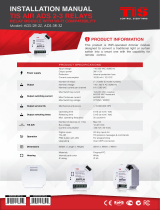
190-01499-00 Rev. F GTX 335/345 Pilot’s Guide v
Copyright Information
TABLE OF CONTENTS
1 GTX 3X5 Series Transponders ....................................................................................... 1-1
1.1 GTX 335 Transponder ................................................................................................... 1-1
1.2 GTX 345 Transponder ................................................................................................... 1-1
2 GTX 3X5 Controls ........................................................................................................... 2-1
2.1 Panel Mount Transponder Controls ............................................................................... 2-1
2.2 Mode Selection Keys ..................................................................................................... 2-1
2.3 Squawk Code Keys ....................................................................................................... 2-3
2.4 Function Keys ................................................................................................................ 2-4
2.5 Remote Transponder Control ........................................................................................ 2-4
3 Display Functions and Settings ..................................................................................... 3-1
3.1 Transponder (XPDR) ...................................................................................................... 3-1
3.2 Timers (TMR) ................................................................................................................. 3-2
3.3 Altitude (ALT) ................................................................................................................ 3-3
3.4 System (SYS) ................................................................................................................. 3-4
3.4.1 Bluetooth Pairing Instructions ............................................................................... 3-5
3.4.2 Bluetooth Paired Device Information ..................................................................... 3-5
4 ADS-B IN Traffic (GTX 345 Only) .................................................................................... 4-1
4.1 Traffic Alerting .............................................................................................................. 4-2
4.2 Helicopter Traffic Alerting ............................................................................................. 4-2
4.2.1 On Scene Mode .................................................................................................... 4-2
4.2.2 No Source of Heading Data .................................................................................. 4-3
4.3 TCAD/TAS/TCAS I GTX 345 Integration ......................................................................... 4-3
5 FIS-B Weather and Flight Information .......................................................................... 5-1
6 Connext Bluetooth ......................................................................................................... 6-1
7 Troubleshooting ............................................................................................................. 7-1
7.1 Transponder Failures ..................................................................................................... 7-1
7.2 Transponder System Messages ...................................................................................... 7-2
List of Figures
Figure 2-1 Squawk Code Entry Field ..................................................................................... 2-3
Figure 3-1 Flight ID Edit Display Page .................................................................................... 3-1
Figure 3-2 Flight ID Editable Display Page ............................................................................. 3-1
Figure 3-3 Bluetooth Page ..................................................................................................... 3-5
Figure 3-4 Bluetooth Pair Request Page ................................................................................ 3-5
Figure 3-5 Paired Device List Page ......................................................................................... 3-5
Figure 3-6 Auto-reconnect Page ........................................................................................... 3-5
Figure 3-7 Unpair Device? Page ............................................................................................ 3-6
Figure 3-8 (Selected) Bluetooth Device Name Page ............................................................... 3-6
Figure 7-1 ADS-B 1090 Failed Screen .................................................................................... 7-1
Figure 7-2 ADS-B 1090 and Transponder Failed Screen ......................................................... 7-1
List of Tables
Table 2-1 Mode Section Key Functions ................................................................................ 2-2
Table 2-2 Squawk Code Key Functions ................................................................................ 2-3
Table 2-3 Squawk Codes ..................................................................................................... 2-3
Table 2-4 Function Keys ...................................................................................................... 2-4
Table 5-1 FIS-B Weather Products ........................................................................................ 5-2
Table 6-1 GTX 345 Connext Features .................................................................................. 6-1
Table 7-1 Troubleshooting .................................................................................................. 7-2






















